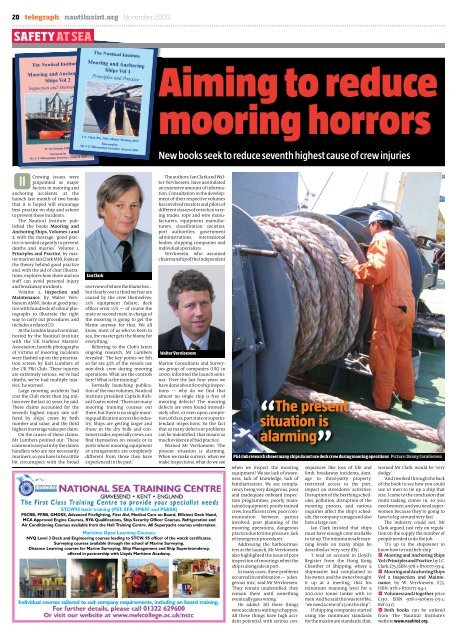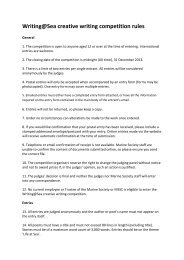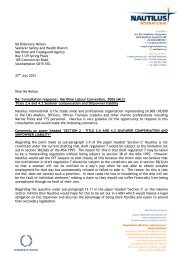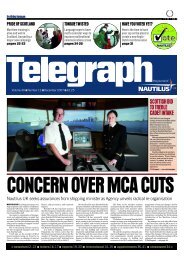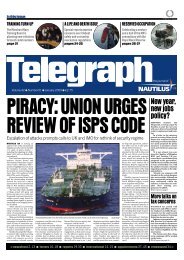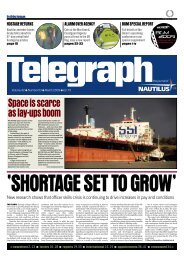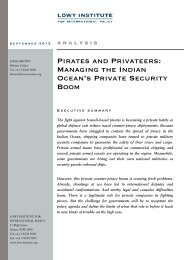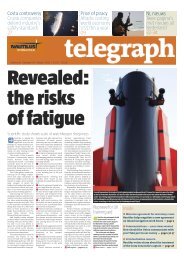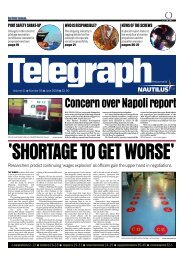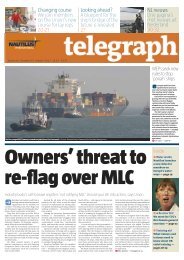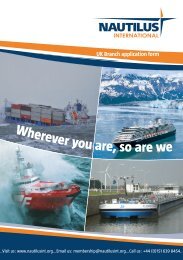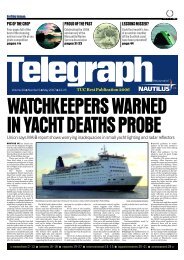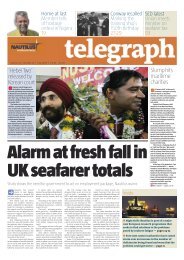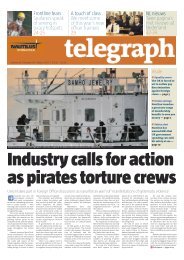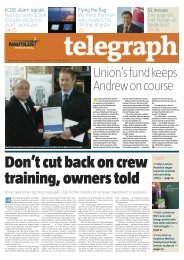NAUTILUS P01 NOVEMBER 2009.qxd - Nautilus International
NAUTILUS P01 NOVEMBER 2009.qxd - Nautilus International
NAUTILUS P01 NOVEMBER 2009.qxd - Nautilus International
Create successful ePaper yourself
Turn your PDF publications into a flip-book with our unique Google optimized e-Paper software.
20 | telegraph | nautilusint.org | November 2009<br />
SAFETY AT SEA<br />
Aiming to reduce<br />
mooring horrors<br />
c<br />
Crewing issues were<br />
pinpointed as major<br />
factors in mooring and<br />
anchoring accidents, at the<br />
launch last month of two books<br />
that it is hoped will encourage<br />
best practice on ship and ashore<br />
to prevent these incidents.<br />
The Nautical Institute published<br />
the books Mooring and<br />
Anchoring Ships, Volumes 1 and<br />
2, with the message; ‘good practice<br />
is needed urgently to prevent<br />
deaths and injuries’. Volume 1,<br />
Principles and Practice, by master<br />
mariner Ian Clark MNI, looks at<br />
the theory behind good practice<br />
and, with the aid of clear illustrations,<br />
explores how shore and sea<br />
staff can avoid personal injury<br />
and breakaway incidents.<br />
Volume 2, Inspection and<br />
Maintenance, by Walter Vervloesem<br />
AMNI, looks at good practice<br />
with hundreds of colour photographs<br />
to illustrate the right<br />
way to carry out procedures, and<br />
includes a related CD.<br />
At the London launch seminar,<br />
hosted by the Nautical Institute<br />
with the UK Harbour Masters’<br />
Association, horrific photographs<br />
of victims of mooring incidents<br />
were flashed up on the presentation<br />
screen by Karl Lumbers of<br />
the UK P&I Club. ‘These injuries<br />
are extremely serious: we’ve had<br />
deaths, we’ve had multiple injuries,’<br />
he warned..<br />
Large mooring accidents had<br />
cost the Club more than $34 million<br />
over the last 20 years, he said.<br />
These claims accounted for the<br />
seventh highest injury rate suffered<br />
by ships’ crews by both<br />
number and value, and the third<br />
highest in average value per claim.<br />
On the causes of these claims,<br />
Mr Lumbers pointed out: ‘These<br />
comments are put in by the claims<br />
handlers who are not necessarily<br />
mariners, so you have to be a little<br />
bit circumspect with the broad<br />
Ian Clark<br />
overview of where the blame lies …<br />
but clearly over a third we fear are<br />
caused by the crew themselves;<br />
25% equipment failure; deck<br />
officer error 15% — of course the<br />
mate or second mate in charge of<br />
the mooring is going to get the<br />
blame anyway for that. We all<br />
know, most of us who’ve been to<br />
sea, the master gets the blame for<br />
everything.’<br />
Referring to the Club’s latest<br />
ongoing research, Mr Lumbers<br />
revealed: ‘The key points we felt<br />
so far are 43% of the vessels use<br />
non-deck crew during mooring<br />
operations. What are the controls<br />
here? What is the training?’<br />
Formally launching publication<br />
of the two volumes, Nautical<br />
Institute president Captain Richard<br />
Coates noted: ‘There are many<br />
mooring training courses out<br />
there, but there is no single mooring<br />
qualification across the industry.<br />
Ships are getting larger and<br />
those in the dry bulk and container<br />
trades, especially crews, can<br />
find themselves on vessels or in<br />
ports where mooring equipment<br />
or arrangements are completely<br />
different from those they have<br />
experienced in the past.’<br />
The authors, Ian Clark and Walter<br />
Vervloesem, have assimilated<br />
an extensive amount of information.<br />
Consultation in the development<br />
of their respective volumes<br />
has involved masters and pilots of<br />
different classes of vessels in varying<br />
trades, rope and wire manufacturers,<br />
equipment manufacturers,<br />
classification societies,<br />
port authorities, government<br />
administrations, international<br />
bodies, shipping companies and<br />
individual specialists.<br />
Vervloesem, who assumed<br />
chairmanship of the Independent<br />
Marine Consultants and Surveyors<br />
group of companies (UK) in<br />
2000, informed the launch seminar:<br />
‘Over the last four years we<br />
have done about 800 ship inspections<br />
— why do we find that<br />
almost no single ship is free of<br />
mooring defects? The mooring<br />
defects are even found immediately<br />
after, or even upon completion,<br />
of class, port state or superintendant<br />
inspections. So the fact<br />
that so many defects or problems<br />
can be indentified, that means so<br />
much evidence of bad practice.’<br />
Warned Mr Vervloesem: ‘The<br />
present situation is alarming.<br />
When we make surveys, when we<br />
make inspections, what do we see<br />
STCW95 basic training (PST, EFA, FP&FF and PS&SR)<br />
PSCRB, PFRB, GMDSS, Advanced Firefighting, First Aid, Medical Care on Board, Efficient Deck Hand,<br />
MCA Approved Engine Courses, RYA Qualifications, Ship Security Officer Courses. Refrigeration and<br />
Air Conditioning Courses available from the Hall Training Centre. All Superyacht courses undertaken.<br />
Maritime Open Learning Courses:<br />
NVQ Level 3 Deck and Engineering courses leading to STCW. 95 officer of the watch certificates.<br />
Surveying courses available through the school of Marine Surveying.<br />
Distance Learning courses for Marine Surveying, Ship Management and Ship Superintendency,<br />
offered in partnership with Lloyds Maritime Academy.<br />
New books seek to reduce seventh highest cause of crew injuries<br />
Walter Vervloesem<br />
“<br />
The present<br />
situation is<br />
alarming<br />
”<br />
P&I club research shows many ships do not use deck crew during mooring operations Picture: Danny Cornilessen<br />
when we inspect the mooring<br />
equipment? We see lack of awareness,<br />
lack of knowledge, lack of<br />
familiarisation. We see complacency<br />
being very dangerous, poor<br />
and inadequate onboard inspection<br />
programmes, poorly maintained<br />
equipment, poorly trained<br />
crew, insufficient crew, poor communication<br />
between parties<br />
involved, poor planning of the<br />
mooring operations, dangerous<br />
practice due to time pressure, lack<br />
of emergency procedures.’<br />
Addressing the harbourmasters<br />
at the launch, Mr Vervloesem<br />
also highlighted the issue of poor<br />
inspection of moorings when the<br />
ship is alongside in port.<br />
In many cases, these problems<br />
occurred in combination — ‘a dangerous<br />
mix’, said Mr Vervloesem:<br />
‘They remain unidentified; they<br />
remain there until something<br />
eventually goes wrong.’<br />
He added: ‘All these things<br />
were accidents waiting to happen.<br />
All these things have high accident<br />
potential, with serious consequences<br />
like loss of life and<br />
limb, breakaway incidents, damage<br />
to third-party property,<br />
restricted access to the port,<br />
impact on stevedores’ activities.<br />
Disruption of the berthing schedules,<br />
pollution, disruption of the<br />
mooring process, and various<br />
inquiries affect the ship’s schedule,<br />
the company’s image and also<br />
have a large cost.’<br />
Ian Clark insisted that ships<br />
must have enough crew available<br />
to tie up. The minimum safe manning<br />
levels on many ships he<br />
described as ‘very, very iffy’.<br />
‘I read an account in Lloyd’s<br />
Register from the Hong Kong<br />
Chamber of Shipping, where a<br />
shipmaster had complained to<br />
his owner, and the owner brought<br />
it up at a meeting, that his<br />
minimum manning level for a<br />
200,000 tonne tanker with 10<br />
men. And he said this was terrible,<br />
“we need a crew of 25 on the ship”.’<br />
If shipping companies started<br />
using the minimum standards<br />
for the maximum standards, that,<br />
warned Mr Clark, would be ‘very<br />
dodgy’.<br />
‘And I worked through the back<br />
of the book to see how you could<br />
use 10 men to tie up a ship that<br />
size. I came to the conclusion that<br />
multi-tasking comes in, so you<br />
need women, and you need superwomen<br />
because they’re going to<br />
have to leg-around very fast’.<br />
The industry could not, Mr<br />
Clark argued, just rely on regulation<br />
on the supply the number of<br />
people needed to do the job.<br />
‘It’s up to the shipowner to<br />
know how to run their ship.’<br />
g Mooring and Anchoring Ships<br />
Vol 1 Principles and Practice, by I. C.<br />
Clark, £75, ISBN: 978-1-870077-93-4.<br />
g Mooring and Anchoring Ships<br />
Vol 2 Inspection and Maintenance,<br />
by W. Vervloesem, £75,<br />
ISBN: 978-1-870077-94-1.<br />
g Volumes 1 and 2 together, price<br />
£130; ISBN 978-1-906915-03-2;<br />
Ref 0317.<br />
g Both books can be ordered<br />
from The Nautical Institute’s<br />
website www.nautinst.org.<br />
NW Kent College 10 x 3.indd 1 16/4/09 14:29:58


